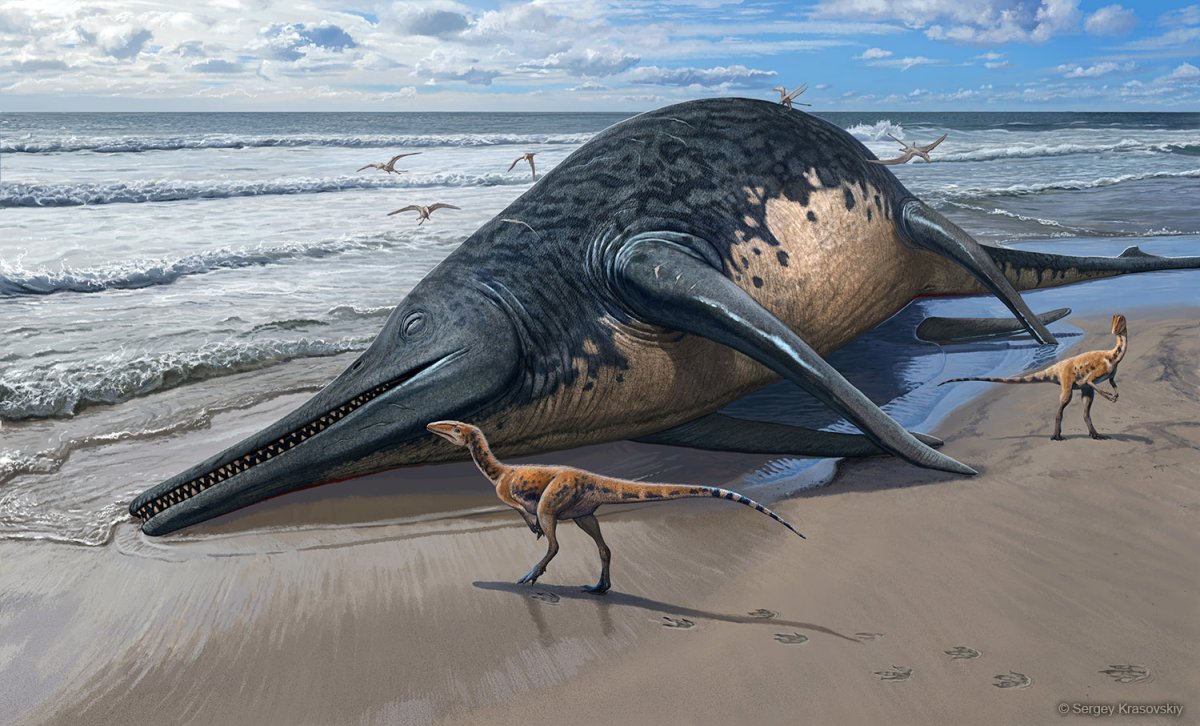Paleontologists have announced the discovery of a colossal marine reptile that may be the largest ever to have roamed Earth's oceans.
The newly identified species, described in a study published in the journal PLOS ONE, is an ichthyosaur, a group of extinct marine reptiles that somewhat resemble modern-day dolphins.
Ichthyosaurs inhabited the world's oceans between roughly 250 million and 90 million years ago. While their existence coincided with the age of the dinosaurs, they are not dinosaurs.
Dubbed Ichthyotitan severnensis, this newly described species is estimated to have reached huge proportions, possibly measuring 25 meters (82 feet) in length, which is comparable to the size of some blue whales.

However, the researchers caution that further evidence is required to conclusively determine the size of this prehistoric titan, given that the new species has been described based on just two separate jawbones found in the United Kingdom. Both fossils represent a type of long, curved bone known as the surangular, which is found in most land vertebrates—except mammals—at the top of the lower jaw, just behind the teeth.
One of the jawbones, which measures more than 6 feet in length, was discovered on a beach in the county of Somerset, southwestern England, by a father and daughter team, Justin and Ruby Reynolds (who was 11 at the time).
The pair spotted the first pieces of the jawbone in May 2020, at a location known as Blue Anchor while searching for fossils. They quickly realized they had found something significant and contacted renowned ichthyosaur expert and lead author of the study Dean Lomax, a paleontologist affiliated with the University of Bristol and University of Manchester in the U.K.
Excited by the discovery, Lomax contacted seasoned fossil collector Paul de la Salle, who had previously found another giant, albeit incomplete, surangular bone in May 2016, at a site few miles along the Somerset coast from Blue Anchor called Lilstock. This bone was previously described in a PLOS ONE paper published by Lomax, Salle and colleagues in 2018.
Following their initial discovery at Blue Anchor, the Reynolds family, alongside Lomax, subsequently returned to site and found additional pieces of the same jawbone.
The fact that Blue Anchor and Lilstock lie within the Westbury Mudstone geological formation helped the research team to link the two surangular bones found a few years apart and determine that they represented a new ichthyosaur species. The more recently discovered of the two bones is more complete and better-preserved.
"Having two examples of the same bone with the same unique features from the same geologic time zone supports our identifications of something new, especially when combined with the fact that these two bones appear roughly 13 million years after their latest geologic relatives with a name," Lomax told Newsweek.
After first appearing around 250 million years ago, ichthyosaurs had evolved to reach at least around 49 feet in length within the space of a few million years. By the end of the Late Triassic period (237 to 201 million years ago), the largest of these marine reptiles had emerged, including I. severnensis, whose fossils date to around 202 million years ago.

But while some ichthyosaur species continued to roam the oceans for millions of years, the giant members of this group appear to have gone extinct during a mass extinction event that occurred at the boundary of the Triassic and Jurassic periods around 200 million years ago.
"Ichthyotitan severnensis is the last ichthyosaur in a long line of giant sized species, i.e. those over 15 meters [49 feet] or more," Lomax said. "We think that it is the very last species of the family Shastasauridae. At 202 million years old, their fossils narrowly predate a major, global extinction event, after which these giants go extinct. Marine reptiles never reach such enormous sizes again."

Lomax praised the role of the Reynolds family in enabling the description of the new ichthyosaur species.
"I was highly impressed that Ruby and Justin correctly identified the discovery as another enormous jawbone from an ichthyosaur," Lomax said in a press release. "They recognized that it matched the one we described in 2018. I asked them whether they would like to join my team to study and describe this fossil, including naming it. They jumped at the chance. For Ruby, especially, she is now a published scientist who not only found but also helped to name a type of gigantic prehistoric reptile. There are probably not many 15 year olds who can say that!
"It is quite remarkable to think that gigantic, blue whale-sized ichthyosaurs were swimming in the oceans around what was the U.K. during the Triassic Period. These jawbones provide tantalizing evidence that perhaps one day a complete skull or skeleton of one of these giants might be found. You never know."
Do you have a tip on a science story that Newsweek should be covering? Do you have a question about paleontology? Let us know via science@newsweek.com.
Uncommon Knowledge
Newsweek is committed to challenging conventional wisdom and finding connections in the search for common ground.
Newsweek is committed to challenging conventional wisdom and finding connections in the search for common ground.
About the writer
Aristos is a Newsweek science reporter with the London, U.K., bureau. He reports on science and health topics, including; animal, ... Read more
To read how Newsweek uses AI as a newsroom tool, Click here.








